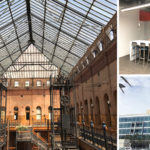By Tucker Hughes
The Los Angeles County office market has been strong, experiencing 15 positive quarters of space absorption in the last 20 quarters alone. The start of 2018 was a departure from the trend, with total vacancy going the opposite direction, and increasing by a nominal amount. The direct vacancy rate remained unchanged primarily, notwithstanding a few fractions of a percent, however, sublease vacancy increased dramatically, up 34% from the average experienced in 2017. It’s important to keep this in context when evaluating the overall health of the market, as the total amount of all available office sublease space amounts to only 5.4 million square feet of space, which is a fraction of the markets 417 million square feet of total buildings. Direct vacancy ended at 10.1% with sublease vacancy ending at 0.6% for a total vacancy rate of 10.7%.
As is required for vacancy rates to have increased in any given quarter, we experienced negative absorption across both direct and sublease channels. Net absorption factors in new deliveries of space to the market when calculating the total space leased relative to the total space vacated. The direct net absorption would have been flat for the first quarter, resulting in no change to vacancy from prior quarters, if we adjusted for the 700,000 square feet of new buildings that were delivered to the market. That said, there is still an additional 5.3 million square feet of office space under construction, the vast majority of which should deliver inside of the next two years. Landlords are building because they are confident in the market, and they are primarily building in markets that are punctuated by strong leasing activity, even so, it’s a lot of space to be delivered in a relatively short period of time.
Due to both organic growth and expensive new product being pumped into the market, rents are on the rise, but not by a significant amount in any given quarter. The average all-in rental rate for 2017 was $2.94 and at the end of the first quarter that number had increased to $2.99 per square foot. Certain markets, particularly markets on the Westside of Los Angeles, have increased by much more dramatic rates and can stretch in excess of twice the market average from a pricing standpoint. Similarly, there are markets with flat rental growth with rents that are much lower than the average.
The industrial and flex markets across Los Angeles county continue to be remarkably strong with vacancy holding tight and not once rising over 3% in the last three years. While vacancy did nominally increase in this most recent quarter, it is still at an unprecedentedly low 2.5%. This change was driven by nominal increases in both direct and sublease availabilities with both segments contributing equally to the increase. In the context of a 927 million square foot industrial market, this results in a total available 41 million square feet of space. Of the available space, a moderate portion represent either new deliveries, which come with a high price tag, or less functional facilities which may lack adequate clear height, dock loading, and/or power requirements.
All of the foregoing contributes to a market where companies are more challenged than they were in the past when it comes to finding new space for their growth, which gives rise to increases in rental rates. The average triple net rental rate, a structure where tenants pay the building’s expenses, ended at $0.94 per square foot by the end of the first quarter. This was up from the 2017 average of $0.91 per square foot. While this increase is representative of the percentage increases being experienced generally across the county, the average rents themselves are misleading. Rental rates, particularly for tenants in the more eastern or northern markets of Los Angeles, can find functional space for materially less. These average rental numbers also factor in the more expensive “flex” space, which means the average for industrial users will always be lower.
Unlike the office market, the industrial sector has a tiny development pipeline of just 2.75 million square feet under construction. This will increase the total market size by just a third of a percent, an immaterial amount, with the vast majority of real meaningful square footage additions being added in the Inland Empire.
Tucker Hughes is managing director at Hughes Marino, a global corporate real estate advisory firm that exclusively represents tenants and buyers. As head of Hughes Marino’s Orange County and Los Angeles offices, Tucker specializes in tenant representation and building purchases throughout Southern California. Tucker makes frequent media appearances to speak on the future of commercial real estate, and is also a regular columnist for Entrepreneur.com. Contact Tucker at 1-844-662-6635 or tucker@hughesmarino.com.











